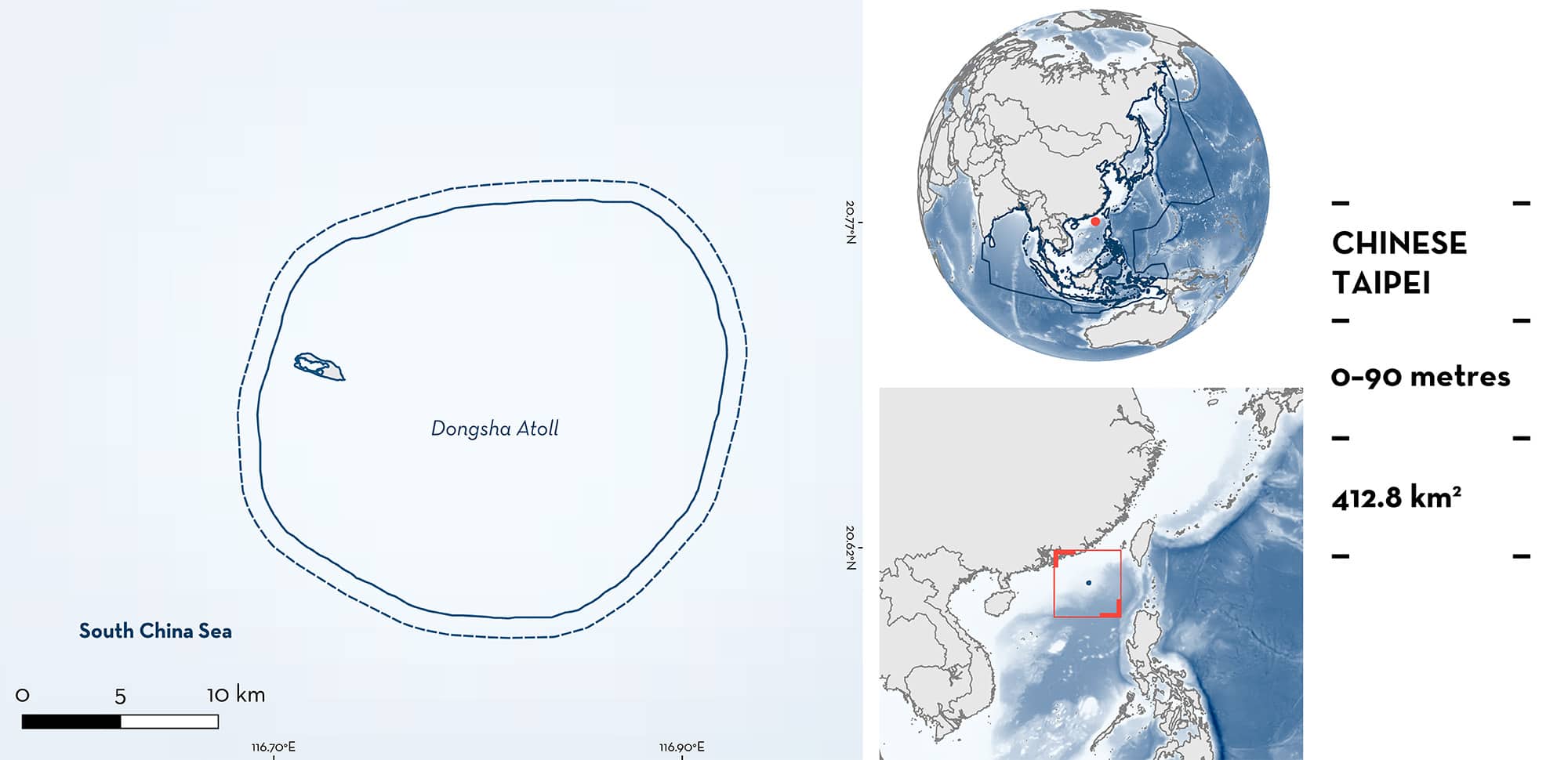ISRA FACTSHEETS
ISRA FACTSHEETS
ASIA REGION
Dongsha Atoll
Summary
Dongsha Atoll is located in Kaohsiung, Chinese Taipei. The atoll includes one islet and is characterised by the presence of extensive seagrass beds, mangroves, and coral reefs. The area overlaps with one protected area, the Dongsha Atoll National Park. Within this area there are: threatened species and reproductive areas (Sharptooth Lemon Shark Negaprion acutidens).
Download factsheet
Dongsha Atoll
DESCRIPTION OF HABITAT
Dongsha Atoll is located in Kaohsiung in Chinese Taipei. The area lies ~450 km southwest from the Taiwan Island. The atoll is in the northern South China Sea and includes one islet on its western side, Dongsha Island (Chou 2016). A single inlet on the western part of the island allows seawater exchange between the inner lagoon and the open ocean, which is dependent on tidal changes. The area is characterised by the presence of extensive seagrass beds (20 times larger than all seagrass beds from Taiwan), mangroves, and coral reefs (Chang et al. 2012). Maximum sea surface temperatures average ~28°C. Minimum temperatures are ~19°C between October–March, during northeast monsoons (Lee et al. 2021).
The area overlaps with the Dongsha Atoll National Park.
This Important Shark and Ray Area is benthopelagic and is delineated from inshore and surface waters (0 m) to 90 m based on the depth range of the Qualifying Species.
CRITERION A
VULNERABILITY
The one Qualifying Species within the area is considered threatened with extinction according to the IUCN Red List of Threatened Species. The Sharptooth Lemon Shark is assessed as Endangered (Simpfendorfer et al. 2021).
CRITERION C
SUB-CRITERION C1 – REPRODUCTIVE AREAS
Dongsha Atoll is an important reproductive area for one shark species.
Sharptooth Lemon Shark is the most abundant shark species at Dongsha Atoll (Lee et al. 2014, 2021). It regularly and predictably aggregates in the lagoon on seagrass beds (Wang & Chen 2014; Chen et al. 2016, 2020). Between 2009–2012, individuals measuring 60–200 cm total length (TL) were observed during an underwater visual census around the island, on seagrass beds and in the intertidal zone (Lee et al. 2014, 2021). Between 2013–2017, 246 neonates with open or recently closed umbilical scars were caught with traps in the lagoon and on seagrass beds (Liu et al. 2023). Individuals were caught in April and May and measured 61.5–88 cm TL, which is close to the known size-at-birth of the species (45–80 cm TL; Ebert et al. 2021). The 246 individuals were tagged either with conventional tags or acoustic transmitters and 55 were recaptured from 47 to 640 days after the first observation, confirming high residency to the area for much of the individuals (Liu et al. 2023). According to acoustic telemetry, individuals <3 years old spend most of the time near the lagoon mouth and their presence is highly influenced by tidal changes (Wang & Chen 2013; Chen et al. 2016, 2020).
Download factsheet
SUBMIT A REQUEST
ISRA SPATIAL LAYER REQUEST
To make a request to download the ISRA Layer in either a GIS compatible Shapefile (.shp) or Google Earth compatible Keyhole Markup Language Zipped file (.kmz) please complete the following form. We will review your request and send the download details to you. We will endeavor to send you the requested files as soon as we can. However, please note that this is not an automated process, and before requests are responded to, they undergo internal review and authorization. As such, requests normally take 5–10 working days to process.
Should you have questions about the data or process, please do not hesitate to contact us.


